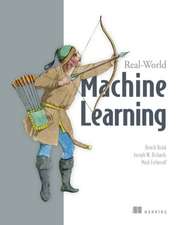Human-Machine Communication for Educational Systems Design: NATO ASI Subseries F:, cartea 129
Editat de Maddy D. Brouwer-Janse, Thomas L. Harringtonen Limba Engleză Paperback – 20 noi 2013
Din seria NATO ASI Subseries F:
- 20%
 Preț: 650.27 lei
Preț: 650.27 lei - 20%
 Preț: 668.55 lei
Preț: 668.55 lei - 20%
 Preț: 992.44 lei
Preț: 992.44 lei - 18%
 Preț: 1239.19 lei
Preț: 1239.19 lei - 20%
 Preț: 1928.45 lei
Preț: 1928.45 lei - 20%
 Preț: 654.37 lei
Preț: 654.37 lei - 18%
 Preț: 1234.00 lei
Preț: 1234.00 lei - 20%
 Preț: 709.78 lei
Preț: 709.78 lei - 20%
 Preț: 656.03 lei
Preț: 656.03 lei - 18%
 Preț: 1854.94 lei
Preț: 1854.94 lei - 20%
 Preț: 374.97 lei
Preț: 374.97 lei - 20%
 Preț: 991.94 lei
Preț: 991.94 lei - 20%
 Preț: 671.02 lei
Preț: 671.02 lei - 20%
 Preț: 1925.96 lei
Preț: 1925.96 lei - 20%
 Preț: 994.73 lei
Preț: 994.73 lei -
 Preț: 389.49 lei
Preț: 389.49 lei - 20%
 Preț: 657.99 lei
Preț: 657.99 lei - 20%
 Preț: 655.20 lei
Preț: 655.20 lei - 18%
 Preț: 1225.31 lei
Preț: 1225.31 lei - 18%
 Preț: 952.09 lei
Preț: 952.09 lei - 20%
 Preț: 332.06 lei
Preț: 332.06 lei - 20%
 Preț: 1284.47 lei
Preț: 1284.47 lei - 20%
 Preț: 644.81 lei
Preț: 644.81 lei -
 Preț: 395.85 lei
Preț: 395.85 lei - 18%
 Preț: 1221.07 lei
Preț: 1221.07 lei - 15%
 Preț: 643.34 lei
Preț: 643.34 lei - 20%
 Preț: 645.47 lei
Preț: 645.47 lei - 20%
 Preț: 1282.98 lei
Preț: 1282.98 lei - 20%
 Preț: 656.36 lei
Preț: 656.36 lei - 20%
 Preț: 1283.31 lei
Preț: 1283.31 lei - 20%
 Preț: 1924.15 lei
Preț: 1924.15 lei - 20%
 Preț: 362.24 lei
Preț: 362.24 lei
Preț: 335.69 lei
Preț vechi: 419.61 lei
-20% Nou
Puncte Express: 504
Preț estimativ în valută:
64.24€ • 66.98$ • 53.39£
64.24€ • 66.98$ • 53.39£
Carte tipărită la comandă
Livrare economică 20 martie-03 aprilie
Preluare comenzi: 021 569.72.76
Specificații
ISBN-13: 9783642851063
ISBN-10: 3642851061
Pagini: 364
Ilustrații: X, 349 p.
Dimensiuni: 155 x 235 x 19 mm
Greutate: 0.51 kg
Ediția:Softcover reprint of the original 1st ed. 1994
Editura: Springer Berlin, Heidelberg
Colecția Springer
Seria NATO ASI Subseries F:
Locul publicării:Berlin, Heidelberg, Germany
ISBN-10: 3642851061
Pagini: 364
Ilustrații: X, 349 p.
Dimensiuni: 155 x 235 x 19 mm
Greutate: 0.51 kg
Ediția:Softcover reprint of the original 1st ed. 1994
Editura: Springer Berlin, Heidelberg
Colecția Springer
Seria NATO ASI Subseries F:
Locul publicării:Berlin, Heidelberg, Germany
Public țintă
ResearchCuprins
1: Fundamentals of Human Perception and Reasoning.- Activity Theory: Implications for Human Computer Interaction.- Motion as a Variable of Visual Communication.- Laws of Visual Perception and Their Consequences for the User Interface.- Learning in Neural Networks.- The Probabilistic Retreat From Biases: Implications for Man-Machine Communication?.- Cognitive Load and the Acquisition of a Problem Solving Skill.- Referring in a Shared Workspace.- Rules in Dialogue.- Models of User Behaviour and Measures of Usability.- Behavioral and Perceptual Responses to the Constraints of Computer-Mediated Design.- The Acquisition of Troubleshooting Skill Implications for Tools for Learning.- Problems of Adaptive Action-Oriented User-Interfaces.- 2: New Media: Enabling Technologies.- New Human-Computer Interaction Techniques.- “Class, You’re Not Making Enough Noise!” The Case for Sound-Effects in Educational Software.- Electronic Books and their Potential for Interactive Learning.- A Change of View: The Parameter Projection Problem in Three-Dimensional View Setting.- Animated Icons Promote Learning of Their Functions.- Generating Natural Language in an Immersive Language Learning System.- 3: Artificial Intelligence, Software and Design Techniques.- Cooperative Problem Solving as a Basis for Computer Assisted Learning.- The Design of Interacting Agents for Use in Interfaces.- Simulator-Based Training Using a Learning Companion.- Knowledge-Based Interface for Existing Systems.- Dialogue of Partners as a Method of Non-Formal Problem Solving.- Modeling a Partner in a Dialogue.- A Visual Knowledge Elicitation Language and Methodology for Acquiring Non-Verbal Expertise.- Visual Programming of Robots in Virtual Environments.- 4: Advanced Applications.- Interactive Learning and NaturalLanguage Systems.- The Learner’s Partner: Foreign Language Learning and Real World Encounters.- Psychological Peculiarities of Man-Machine Communication in Instructional Systems.- A Design for Accessing Multimedia Information Using Cohesion.- WISH: Writing Instruction Script in Hebrew.- A Method of Evaluating the Usability of a Prototype User Interface for CBT Courseware.- A Visual Display System for the Teaching of Intonation to Deaf Persons: An Explorative Study.- XProc Sim: An X Window Based GUI for the Dynamic Simulation of the Chemical Recovery Cycle of a Paper Pulp Mill.- Telephone Information System: Dialogue Specification Language.- Improving Functional Programming Environments for Education.- Designing an Intelligent Interface for an Advice-Giving System.- List of Participants.

















